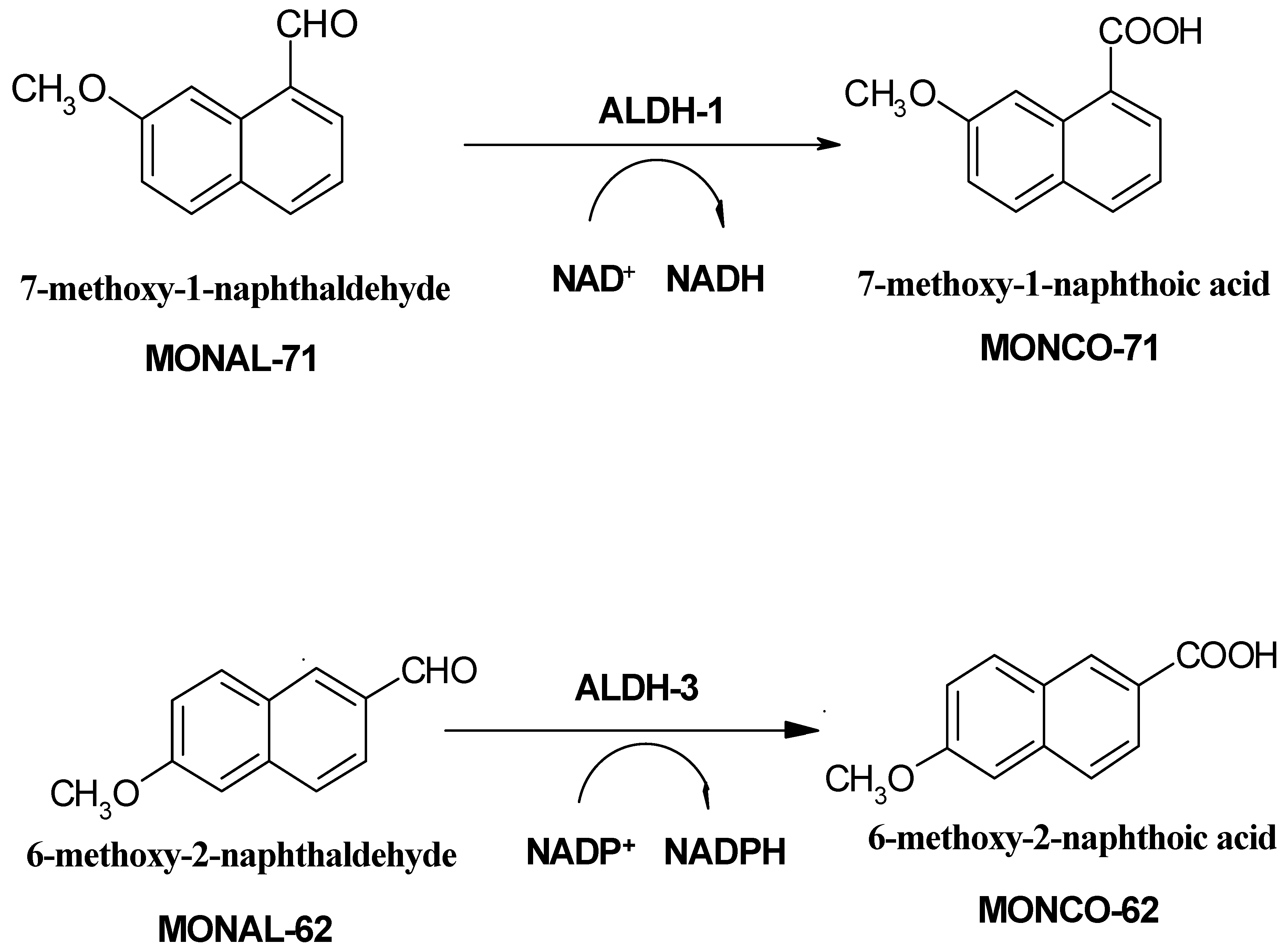Determination of Aldehyde Dehydrogenase (ALDH) Isozymes in Human Cancer Samples - Comparison of Kinetic and Immunochemical Assays
Abstract
:Introduction

Results and Discussion
| Sample | Fluorimetric analysis | Western Blot analysis | ||
|---|---|---|---|---|
| ALDH1A1 | ALDH3A1 | ALDH1A1 | ALDH3A1 | |
| Colon tumour 1 | 0.14 (0.06) | 0.07 (0.02) | ++ (+) | ± (±) |
| Colon tumour 2 | 0.09 (0.08) | 0.05 a (0.10) | + (+) | - (+) |
| Colon tumour 3 | 0.21 (0.15) | 0.17 (0.1 a) | ++ (+) | + (±) |
| Colon tumour 4 | 0.13 (0.38) | 0.01a (0.05) | + (++) | ± (++) |
| Colon tumour 5 | 0.07 (0.08) | 0.04 (0.07) | ++ (++) | ++ (++) |
| Liver cancer 6 | 0.14 (1.4) | 1.61 (1.61) | -(++) | +(+) |
| Liver cancer 7 | 0.19 (2.5) | 0.51 (0.66) | +(++) | +++(+++) |
| Stomach tumour 8 | 0.28 (0.73) | 0.18 (1.75) | +(++) | +(++) |

Conclusions
Experimental
General
Western Blot Tests
Fluorimetric procedure
References and Notes
- Lindahl, R. Aldehyde dehydrogenases and their role in carcinogenesis. Crit. Revs. Biochem. Mol. Biol. 1992, 27, 283–335. [Google Scholar] [CrossRef]
- Sladek, N. E. Aldehyde dehydrogenase-mediated cellular relative insensitivity to the oxazaphosphorines. Curr. Pharm. Des. 1999, 5, 607–625. [Google Scholar]
- Moreb, J.; Schweder, M.; Suresh, A.; Zucali, J. R. Overexpression of the human aldehyde dehydrogenase class I results in increased resistance to 4-hydroperoxycyclophosphamide. Cancer Gene Therapy 1996, 3, 24–30. [Google Scholar]
- Moreb, J. S.; Maccow, C.; Schweder, M.; Hecomovich, J. Expression of antisense RNA to aldehyde dehydrogenase class-1 sensitizes tumor cells to 4-hydroperoxycyclophosphamide in vitro. J. Pharmacol. Exper. Therap. 2000, 293, 390–396. [Google Scholar]
- Sreerama, L.; Sladek, N. E. Primary breast tumour levels of suspected molecular determinants of cellular sensitivity.... Cancer Therap. Pharmacol. 2001, 47, 255–62. [Google Scholar]
- Sreerama, L.; Sladek, N. E. Cellular levels of class 1 and class 3 aldehyde dehydrogenases and certain other drug-metabolizing enzymes in human breast malignancies. Clin Cancer Res. 1997, 3, 1901–14. [Google Scholar]
- Wierzchowski, J.; Wroczyński, P.; Laszuk, K.; Interewicz, E. Fluorimetric detection of aldehyde dehydrogenase activity in human blood, saliva and organ biopsies, and kinetic differentiation between class I and class III isozymes. Anal. Biochem. 1997, 245, 69–78. [Google Scholar]
- Wroczyński, P.; Laskowska, A.; Wierzchowski, J.; Szubert, A.; Polański, J.; Słowiaczek, M. Aldehyde dehydrogenase isoenzymes in tumours - assay with possible prognostic value for oxazaphosphorine chemotherapy. Acta Biochim. Pol. 1998, 48, 33–45. [Google Scholar]
- Yin, S. J.; Liao, C. S.; Lee, Y. C.; Wu, C. W.; Jao, S. W. Genetic polymorphism and activities of human colon alcohol and aldehyde dehydrogenases: no gender and age differences. Alcoholism Clin. Exper. Res. 1994, 18, 1256–60. [Google Scholar]
- Helander, A. Aldehyde deydrogenase in blood: distribution, characteristics and possible use as marker of alcohol misuse. Alcohol & Alcoholism 1993, 28, 135–145. [Google Scholar]
- Sample Availability: Available from the authors
© 2002 by MDPI (http://www.mdpi.org). Reproduction is permitted for noncommercial purposes.
Share and Cite
Wroczynski, P.; Wierzchowski, J.; Golab, J.; Blazejczyk, M.; Borecka, D. Determination of Aldehyde Dehydrogenase (ALDH) Isozymes in Human Cancer Samples - Comparison of Kinetic and Immunochemical Assays. Molecules 2002, 7, 896-901. https://doi.org/10.3390/71200896
Wroczynski P, Wierzchowski J, Golab J, Blazejczyk M, Borecka D. Determination of Aldehyde Dehydrogenase (ALDH) Isozymes in Human Cancer Samples - Comparison of Kinetic and Immunochemical Assays. Molecules. 2002; 7(12):896-901. https://doi.org/10.3390/71200896
Chicago/Turabian StyleWroczynski, Piotr, Jacek Wierzchowski, Jakub Golab, Magdalena Blazejczyk, and Dorota Borecka. 2002. "Determination of Aldehyde Dehydrogenase (ALDH) Isozymes in Human Cancer Samples - Comparison of Kinetic and Immunochemical Assays" Molecules 7, no. 12: 896-901. https://doi.org/10.3390/71200896
APA StyleWroczynski, P., Wierzchowski, J., Golab, J., Blazejczyk, M., & Borecka, D. (2002). Determination of Aldehyde Dehydrogenase (ALDH) Isozymes in Human Cancer Samples - Comparison of Kinetic and Immunochemical Assays. Molecules, 7(12), 896-901. https://doi.org/10.3390/71200896




